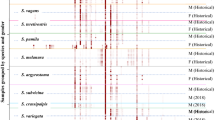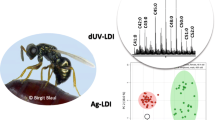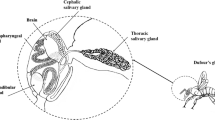Abstract
The cuticular hydrocarbons fromVarroa mites collected in Florida and Italy and their honeybee hosts were characterized by gas chromatography (GC) and by coupled GC-mass spectrometry (MS). AVarroa mite has a hydrocarbon pattern that is qualitatively identical to that of its honeybee host. Mites and all stages of honeybees share a characteristic pattern of prominant alkane components including heneicosane, tricosane, pentacosane, heptacosane, nonacosane and hentriacontane. Adult honey bees and mites from adult bees also have as major components the alkenes 8-nC31:1, 10-nC31:1 and 10-nC33:1, while pupae and mites from pupae have only traces of these alkenes. Coupled GC-MS analysis after addition of dimethyl disulfide (DMDS) was used to determine the location of the double bound in the three prominent alkenes above. The question as to whether the mites simply acquire the hydrocarbons from their hosts or possibly synthesize them was not resolved. No characteristic differences between the hydrocarbons of mites from Italy and from Florida were found. We speculate that the hydrocarbons help the mites avoid desiccation and may help integrate the mites into honeybee colony life.
Similar content being viewed by others
References
Bartelt, R.J. and Jackson, L.L., 1984. Hydrocarbon component of theDrosophila virilis (Diptera: Drosophilidae) aggregation pheromone: (Z)-10-heneicosene. Ann. Entomol. Soc. Am., 77: 364–371.
Blomquist, G.J., Blailock, T.T., Scheetz, R.W. and Jackson, L.L., 1976. Cuticular lipids of insects — VII. Cuticular hydrocarbons of the cricketsAcheta domesticus, Gryllus pennsylvanicus andNemobius fasciatus. Comp. Biochem. Physiol., 54B: 381–386.
Blomquist, G.J., Chu, A.J. and Remaley, S., 1980. Biosynthesis of wax in the honeybee,Apis mellifera L. Insect Biochem., 10: 313–321.
Brand, H.M., Puleo, S.L. and Brand, E.E., 1991. Identification of the Africanized bee in South America by the composition of its wax. Bee Sci., 1: 106–111.
Carlson, D.A., 1988a. Hydrocarbons for identification and phenetic comparisons: cockroaches, honey bees and tsetse flies. Fla. Entomol., 71: 333–345.
Carlson, D.A., 1988b. Africanized and European honey-bee drones and comb waxes: analysis of hydrocarbon components for identification. In: G.R. Needham, R.F. Page Jr., M. Delfinado-Baker and C.E. Bowman (Editors), Africanised Honey Bees and Bee Mites. Ellis Horwood Ltd./John Wiley, New York, NY, pp. 264–274.
Carlson, D.A. and Bolten, A.B., 1984. Identification of Africanized and European honey bees, using extracted hydrocarbons. Bull. Entomol. Soc. Am., 30: 32–35.
Carlson, D.A. and Service, M.W., 1980. Identification of mosquitoes ofAnopheles gambiae species complex A and B by analysis of cuticular components. Science, 207: 1089–1091.
Carlson, D.A. and Walsh, J.F., 1981. Identification of two West African black flies (Diptera: Simuliidae) of theSimulium damnosum species complex by analysis of cuticular paraffins. Acta Tropica, 38: 235–239.
Carlson, D.A. and Yocom, S.R., 1986. Cuticular hydrocarbons from six species of tephritid fruit flies. Arch. Insect Biochem. Physiol., 3: 397–412.
Carlson, D.A., Roan, C-S., Yost, R.A. and Hector, J., 1989. Dimethyl disulfide derivatives of long chain alkenes, alkadienes, and alkatrienes for gas chromatography/mass spectrometry. Anal. Chem., 61: 1564–1571.
Carlson, D.A., Roubik, D.W. and Milstrey, K., 1991. Distinctive hydrocarbons among giant honey bees, theApis dorsata group (Hymenoptera: Apidae). Apidologie, 22: 169–181.
Castner, J.L. and Nation, J.L., 1984. Cuticular lipids for species recognition of mole crickets (Orthoptera: Gryllotalpidae): I.Scapteriscus didactylus, Scapteriscus imitatus andScapteriscus vicinus. Fla. Entomol., 67: 155–160.
Castner, J.L. and Nation, J.L., 1986. Cuticular lipids for species recognition of mole crickets (Orthoptera: Gryllotalpidae): II.Scapteriscus abbreviatus, S. acletus, S. vicinus, S. sp., andNeocurtilla hexadactyla. Arch. Insect Biochem. Physiol., 3: 127–134.
Delfinado-Baker, M. and Aggarwal, K., 1987. A newVarroa (Acari: Varroidae) from the nest ofApis cerana (Apidae). Int. J. Acarol., 13: 233–237.
Denmark, H.A., Cromroy, H.L. and Cutts, L., 1991. Varroa mite,Varroa jacobsoni Oudemans (Acari: Varroidae). Entomol. Circ. No. 347, Fla. Dept. Agric. & Consumer Serv., Div. of Plant Industry, Gainesville, FL, 4 pp.
Dunkelblum, E., Tan, S.H. and Silk, P.J., 1985. Double-bond location in monounsaturated fatty acids by dimethyl disulfide derivatization and mass spectrometry: Application to analysis of fatty acids in pheromone glands of four Lepidoptera. J. Chem. Ecol., 11: 265–277.
Francis, B.R., Blanton, W.E. and Nunamaker, R.A., 1985. Extractable surface hydrocarbons of workers and drones of the genusApis. J. Apic. Res., 24: 13–26.
Francis, B.R., Blanton, W.E., Littlefield, J.L. and Nunamaker, R.A., 1989. Hydrocarbons of the cuticle and hemolymph of the adult honey bee (Hymenoptera: Apidae). Ann. Entomol. Soc. Am., 82: 486–494.
Fuchs, S., 1990. Preference for drone brood cells byVarroa jacobsoni Oud in colonies ofApis mellifera carnica. Apidologie, 21: 193–199.
Griffiths, D.A., Gray, J. and Pegazzano, F., 1983.Varroa — The acarologists' view. In: R. Cavalloro (Editor),Varroa jacobsoni Oud. affecting Honey Bees: Present Status and Needs. Proc. Meet. Ec Experts' Group, Wageningen. A.A. Balkema, Rotterdam, pp. 79–83.
Grobov, O.F., Poulenetz, N.M. and Sofronova, S.L., 1980. La variabilité géographique des dimensions du scutum dorsal des femelles deVarroa jacobsoni Oudemans. In: Le XXVIIe Congrès Int. Apic., Athene, 1979. Apimondia, Bucharest, pp. 381–382.
Howard, R.W. and Blomquist, G.J., 1982. Chemical ecology and bio-chemistry of insect hydrocarbons. Ann. Rev. Entomol., 27: 149–172.
Howard, R.W., McDaniel, C.A. and Blomquist, G.J., 1980. Chemical mimicry as an integrating mechanism: cuticular hydrocarbons of a termitophile and its host. Science, 210: 431–433.
Jackson, L.T. and Baker, G.L., 1970. Cuticular lipids of insects. Lipids, 5: 239–246.
Kovats, E., 1965. Gas chromatographic characterization of organic substances in the retention index system. Adv. Chromatogr., 1: 229–247.
Lavine, B.K., Carlson, D.A., Henry, D. and Jurs, P.C., 1988. Taxonomy based on chemical constitution: differentiation of Africanized honey-bees from European honey-bees. J. Chemometrics, 2: 29–37.
Le Conte, Y., Arnold, G., Trouiller, J., Masson, C., Chappe, B. and Ourisson, G., 1989. Attraction of the parasitic miteVarroa to the drone larvae of honey bees by simple aliphatic esters. Science, 245: 638–639.
Lockey, K.H., 1981. Cuticular hydrocarbons of adultCylindrinotus laevioctostriatus (Goetze) andPhylan gibbus (Fabricius) (Coleoptera: Tenebrionidae). Insect Biochem., 11: 549–561.
Lockey, K.H., 1982. Hydrocarbons of adultOnymacris plana (Peringuey) andOnymacris rugatipennis (Haag) (Coleoptera: Tenebrionidae). Insect Biochem., 12: 69–81.
Lockey, K.H., 1988. Lipids of the insect cuticle: origin, composition and function. Comp. Biochem. Physiol., 89B: 595–645.
McDaniel, C.A., Howard, R.W., Blomquist, G.J. and Collins, A.M., 1984. Hydrocarbons of the cuticle, sting apparatus and sting shaft ofApis mellifera L. Identification and preliminary evaluation as chemotaxonomic characters. Sociobiology, 8: 287–298.
Nation, J.L., Sanford, M.T. and Milne, K., 1991. Comparison of cuticular hydrocarbons fromVarroa mites and honey bees. Am. Bee J., 131: 778–779.
Nelson, D.R., 1978. Long-chain methyl-branched hydrocarbons: Occurrence, biosynthesis, and function. Adv. Insect Physiol., 13: 1–33.
Peng, Y.S., Fang, Y., Xu, S., Ge, L. and Nasr, M.E., 1987. Response of foster Asian honey bee (Apis cerana) colonies to the brood of European honey bees (Apis mellifera) infested with parasitic mite,Varroa jacobsoni. J. Invert. Pathol., 49: 259–264.
Peschke, K., 1987. Cuticular hydrocarbons regulate mate recognition, male aggression, and female choice of the rove beetle,Aleochara curtula. J. Chem. Ecol., 13: 1993–2008.
Smith, R-K., 1990a. Principles of chemical analysis of bee hydrocarbons. Bee Sci., 1: 15–17.
Smith, R-K., 1990b. Chemotaxonomy of honey bees (Apis mellifera L.). Part 1: European and African workers. Bee Sci., 1: 23–32.
Smith, R-K., 1991. Chemotaxonomy of honey bees (Apis mellifera L.). Part 2: Africanized workers. Bee Sci., 1: 82–94.
Vander Meer, R.K. and Wojcik, D.P., 1982. Chemical mimicry in the myrmecophilous beetleMyrmecaphodius excavaticollis. Science, 18: 806–808.
Vander Meer, R.K., Jouvenaz, D.P. and Wojcik, D.P., 1989. Chemical mimicry in a parasitoid (Hymenoptera: Eucharitidae) of fire ants (Hymenoptera: Formicidae). J. Chem. Ecol., 15: 2247–2261.
Author information
Authors and Affiliations
Additional information
Florida Agricultural Experiment Station Journal Series No. R-02473.
Rights and permissions
About this article
Cite this article
Nation, J.L., Sanford, M.T. & Milne, K. Cuticular hydrocarbons fromVarroa jacobsoni . Exp Appl Acarol 16, 331–344 (1992). https://doi.org/10.1007/BF01218575
Issue Date:
DOI: https://doi.org/10.1007/BF01218575




